Landing bay (RDM): Difference between revisions
JubalHarshaw (talk | contribs) (citations) |
(Page facelift and refresh.) |
||
| Line 1: | Line 1: | ||
[[Image:Pegasus | [[Image:Pegasus Landing Bay II.png|thumb|right|A Raptor flies above landing bay 3 on ''[[Pegasus (RDM)|Pegasus]]'' (BS 62).]] | ||
Located in the [[Flight pod|flight pods]] of Colonial battlestars, the '''landing bay''' or '''landing deck''' is the main recovery spot for all inbound vehicles, including [[Viper (RDM)|Vipers]], [[Raptor|Raptors]], [[Atmospheric shuttle|atmospheric shuttles]], and depending on pod size, civilian transports as large as [[Eversun]] starliners. The landing bay is also the main launching location of auxiliary craft that are too large or bulky to launch from the [[Launch tube (TRS)|launch tubes]] below. Landing decks have all the commodities needed to maintain aircraft operations, such as fuel lines, electrical umbilicals, pressurized airlocks, and [[Landram (TRS)|maintenance vehicles]]. | |||
A '''landing | ==Design== | ||
[[Image:Viper Maneuver.png|thumb|left|A Viper maneuvers for landing on a flight deck.]] | |||
Generally, landing bays are designed as large, cavernous landing strips, and can run as ~617 meters (2,025 ft) in length, depending on the size of the battlestar. The bays are almost never pressurized, and do not feature artificial gravity. Instead, they rely on magnetism to bound vessels and people to the deck. This has allowed newer ships, such as the [[Mercury class|''Mercury'' class]], to include multiple landing bays that are "upside down," compared to the rest of the ship ([[TRS]]: "[[Pegasus]]", "[[The Captain's Hand]]", "[[Razor]]"). Because the magnetism does not grab hold of landing ships as quickly as artificial gravity, landing Vipers (especially during [[Combat landing|combat landings]]) will bounce before finally setting down and coming to a stop. This puts dents into the deck, which need to be repaired periodically ([[TRS]]: "[[33]]"). | |||
<br clear="all"/> | |||
[[Image: | ==Operations== | ||
[[Image:Flubbed Landing.png|thumb|right|Viper pilot [[Louanne Katraine|Louanne "Kat" Katraine]], makes a hard landing after failing to obey landing procedures.]] | |||
The landing bays are overseen by the ship's [[Landing Signal Officer|Landing Signal Officer (LSO)]], whose primary role is to direct aircraft operations aboard their assigned vessel. For landing operations, the LSO directs the vehicles into the bay from aft, and relays approach information to the pilot(s). If need be, the LSO calls off the landing, and the pilot has to circle out and back around for another attempt ([[TRS]]: "[[Final Cut]]"). If the approach is good, then the craft is able to fly in and set down on any number of elevators that retract the craft into the [[Hangar deck|hangar deck]], or in the case of large vehicles, connect to airlocks and other umbilical cords. | |||
===Landing Operations=== | |||
*Assisted Landings: In modern Colonial aviation, pilots are assisted by on-board computer systems when landing their craft. The automated systems made landings softer and easier for pilots to accomplish, and reduce the risk of serious accident. However, despite the widespread use of these systems, downtime was to be expected, or in special cases, out-right banned, which require pilots to make "[[Hands-on approach|hands-on approaches]]" ([[TRS]]: "[[Miniseries]]"). | |||
[[Image:Colonial One Docking.png|thumb|right|''Colonial Heavy 798'' lands aboard ''Galactica'' for its decommissioning ceremonies.]] | |||
*Hands-on Landings: Hands-on landings were required when a ship's landing system was down, or in the special case of the battlestar [[Galactica (RDM)|''Galactica'']] (BS 75) - out-right banned by the ship's CO. Hands-on landings are very difficult to accomplish, with the pilot having full control over his or her aircraft all the way until they set down on the landing deck. The skills needed to accomplish this take time to master, and depending on the condition of the pilot, can result in a serious accident and even death if not followed properly ([[TRS]]: "[[Final Cut]]"). | |||
*Combat Landings: [[Combat landing|Combat landings]] are made when pilots are required to quickly land aboard their parent vessel in order to make a quick escape from the combat zone. A combat landing is a drastic form of a non-combat hands-on approach. When a pilot is faced with a combat landing order, more focus is given to the pilot getting on the deck as quickly and safely as possible, and less on proper procedure. Combat landings are often very damaging to both the landing craft and the deck, which have to be repaired at a later date when it is safe to do so ([[TRS]]: "[[33]]"). | |||
*Docking Procedures: Some Colonial vessels, such as the larger battlestars, allow internal docking with smaller transports. Landing procedures for these ships are tricky, requiring training and a steady hand. One miscalculation can result in a collision between the transport and the flight pod. Transports making a docking procedure are guided into the assigned bay, and directed toward an open airlock. Deck hands then are able to attach power and fuel umbilicals, while the passengers are able to depart ([[TRS]]: "[[Miniseries]]"). | |||
== | <br clear="all"/> | ||
===Takeoff Operations=== | |||
[[Image:Landing Bay Crew.png|thumb|left|A Raptor departs the landing deck.]] | |||
[[Image:Osiris Raptor.png|thumb|right|A Raptor departs from ''[[Osiris]]'' (BS 54).]] | |||
For craft too large or bulky to fit in the launch tubes, the landing deck is used as the departing point. These craft were raised to the flight deck by an elevator, then staged for takeoff after being cleared to do so by the LSO. Auxiliary craft needing to depart, usually did so by exiting the front entrance to the flight pod, parallel to the direction of travel of the parent vessel ([[TRS]]: "[[Blood and Chrome]]", "[[Miniseries]]", "[[Resistance]]", "[[Exodus, Part II]]", "[[Someone to Watch Over Me]]"). On smaller Colonial vessels that don't have flight pods, takeoffs are performed from the rear of the vessel, and depart the opposite direction of travel of the parent vessel ("[[Blood and Chrome]]"). | |||
<br clear="all"/> | |||
[[Category:A to Z]] | [[Category:A to Z]] | ||
Revision as of 01:29, 8 August 2013
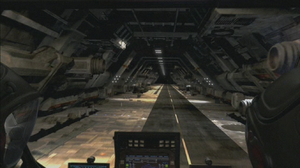
Located in the flight pods of Colonial battlestars, the landing bay or landing deck is the main recovery spot for all inbound vehicles, including Vipers, Raptors, atmospheric shuttles, and depending on pod size, civilian transports as large as Eversun starliners. The landing bay is also the main launching location of auxiliary craft that are too large or bulky to launch from the launch tubes below. Landing decks have all the commodities needed to maintain aircraft operations, such as fuel lines, electrical umbilicals, pressurized airlocks, and maintenance vehicles.
Design[edit]
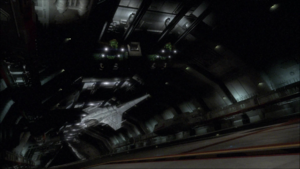
Generally, landing bays are designed as large, cavernous landing strips, and can run as ~617 meters (2,025 ft) in length, depending on the size of the battlestar. The bays are almost never pressurized, and do not feature artificial gravity. Instead, they rely on magnetism to bound vessels and people to the deck. This has allowed newer ships, such as the Mercury class, to include multiple landing bays that are "upside down," compared to the rest of the ship (TRS: "Pegasus", "The Captain's Hand", "Razor"). Because the magnetism does not grab hold of landing ships as quickly as artificial gravity, landing Vipers (especially during combat landings) will bounce before finally setting down and coming to a stop. This puts dents into the deck, which need to be repaired periodically (TRS: "33").
Operations[edit]
The landing bays are overseen by the ship's Landing Signal Officer (LSO), whose primary role is to direct aircraft operations aboard their assigned vessel. For landing operations, the LSO directs the vehicles into the bay from aft, and relays approach information to the pilot(s). If need be, the LSO calls off the landing, and the pilot has to circle out and back around for another attempt (TRS: "Final Cut"). If the approach is good, then the craft is able to fly in and set down on any number of elevators that retract the craft into the hangar deck, or in the case of large vehicles, connect to airlocks and other umbilical cords.
Landing Operations[edit]
- Assisted Landings: In modern Colonial aviation, pilots are assisted by on-board computer systems when landing their craft. The automated systems made landings softer and easier for pilots to accomplish, and reduce the risk of serious accident. However, despite the widespread use of these systems, downtime was to be expected, or in special cases, out-right banned, which require pilots to make "hands-on approaches" (TRS: "Miniseries").
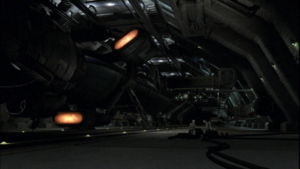
- Hands-on Landings: Hands-on landings were required when a ship's landing system was down, or in the special case of the battlestar Galactica (BS 75) - out-right banned by the ship's CO. Hands-on landings are very difficult to accomplish, with the pilot having full control over his or her aircraft all the way until they set down on the landing deck. The skills needed to accomplish this take time to master, and depending on the condition of the pilot, can result in a serious accident and even death if not followed properly (TRS: "Final Cut").
- Combat Landings: Combat landings are made when pilots are required to quickly land aboard their parent vessel in order to make a quick escape from the combat zone. A combat landing is a drastic form of a non-combat hands-on approach. When a pilot is faced with a combat landing order, more focus is given to the pilot getting on the deck as quickly and safely as possible, and less on proper procedure. Combat landings are often very damaging to both the landing craft and the deck, which have to be repaired at a later date when it is safe to do so (TRS: "33").
- Docking Procedures: Some Colonial vessels, such as the larger battlestars, allow internal docking with smaller transports. Landing procedures for these ships are tricky, requiring training and a steady hand. One miscalculation can result in a collision between the transport and the flight pod. Transports making a docking procedure are guided into the assigned bay, and directed toward an open airlock. Deck hands then are able to attach power and fuel umbilicals, while the passengers are able to depart (TRS: "Miniseries").
Takeoff Operations[edit]
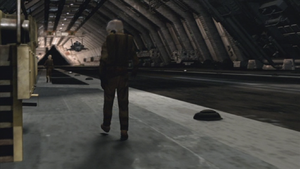
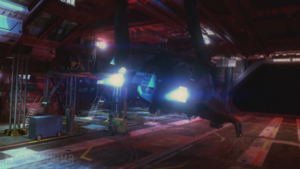
For craft too large or bulky to fit in the launch tubes, the landing deck is used as the departing point. These craft were raised to the flight deck by an elevator, then staged for takeoff after being cleared to do so by the LSO. Auxiliary craft needing to depart, usually did so by exiting the front entrance to the flight pod, parallel to the direction of travel of the parent vessel (TRS: "Blood and Chrome", "Miniseries", "Resistance", "Exodus, Part II", "Someone to Watch Over Me"). On smaller Colonial vessels that don't have flight pods, takeoffs are performed from the rear of the vessel, and depart the opposite direction of travel of the parent vessel ("Blood and Chrome").